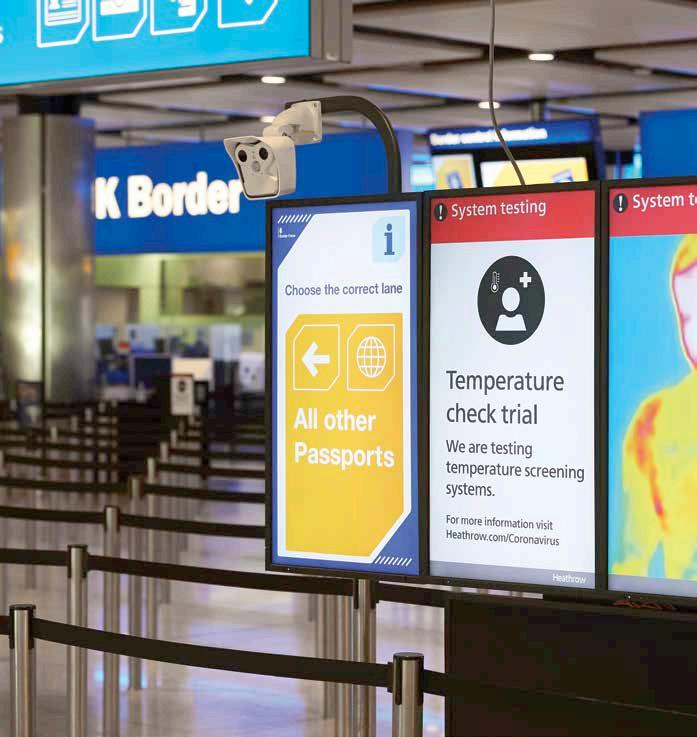
6 minute read
TERMINAL TRAITS
3 0 TERMINAL TRANSFORMATIONS

ABOVE: International airports are adapting to the pandemic; RIGHT: Emirates’ COVID-19 testing at Dubai International How the pandemic is reshaping the airport experience
WORDS SEHER ASAF
Cleaning robots, sanitising booths, rapid blood tests and contactless kiosks – the coronavirus pandemic is transforming the airport experience worldwide.
As border restrictions begin to ease, airports and airlines are looking to restore confidence in travel by redesigning the passenger journey.
Airports have adopted a slew of procedures to deal with new customer expectations, according to Stefano Baronci,
Director General, Airports Council
International (ACI), Asia Pacific.
“There are a number of measures airports are considering or have already implemented to create what we call the ‘healthy passenger experience’, which focuses on preventing the risk of [COVID-19] transmission from passenger to passenger,” he explains.
“Passengers now expect sanitation measures, contactless journeys, physical distance with other travellers and clear instructions on how to stay safe.”
Here, Business Traveller takes a closer look at how the COVID-19 crisis is changing airport experiences around the world.
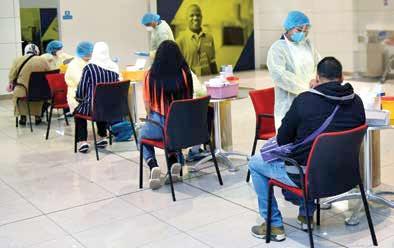
CONTACTLESS TRAVEL The coronavirus crisis could speed up the adoption of technology that offers a low-touch or even touch-less travel experience at airports.
In May, Malaysian low-cost airline Air Asia introduced contactless kiosks and payment options at airports in Malaysia, Thailand, Philippines, Indonesia and Japan where it operates air services. Passengers can check-in and make payments using airport systems without having to actually touch them, according to the carrier.
In Abu Dhabi, Etihad Airways is testing contactless health screening kiosks that can monitor a passenger’s temperature, heart rate and respiratory rate to help identify those that might have early COVID-19 symptoms.
According to the UAE national carrier, the system will automatically suspend the self-service check-in or bag drop process if a passenger’s vital signs show potential symptoms of illness. It will then divert to a teleconference or alert staff at the airport, who will make “further assessments” and “manage travellers as appropriate”.
The airline also recently teamed up with Mediclinic Middle East to offer UAE-based travellers a convenient COVID-19 PCR testing service at their home or at a Mediclinic facility before they travel. It’s part of the recently introduced Etihad Wellness sanitisation and safety programme, which aims to maintain health and hygiene standards at every stage of the passenger journey.
According to Sumesh Patel, Asia Pacific President at SITA, an IT company providing services to the air transport industry, many familiar airport procedures could soon be a thing of the past.
For example, physical check-in desks could be replaced by online or mobile check-in services as airports and airlines look to restore consumer confidence in travel.
“Your mobile phone will become your boarding pass and you will be more comfortable using your own device rather than third-party devices at the airport,” says Patel. Etihad Airways is Although mobile testing contactless boarding passes have health screening been available for some time, the pandemic kiosks to monitor could make the use of passengers electronic passes more pervasive, he adds Biometric technology that relies on facial recognition could also offer a potential solution to airports looking to minimise touch during the passenger journey. This type of technology scans and captures a passenger’s biometric details to verify their identity. Once checked against the passenger’s travel documents, a secure digital travel ID is created, which can be used all the way from the self-service check-in to boarding.
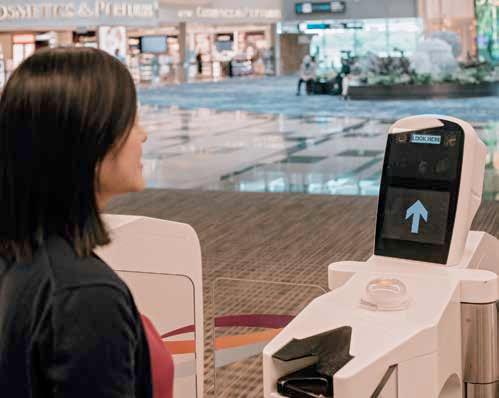
ABOVE: Iris and facial recognition for immigration clearance
“When you walk through the airport terminal, your face is your passport so you don’t need to touch anything. When you go to the bag drop you just stand next to it and it recognises you. You don’t need to produce any documents; your face is good enough,” Patel explains.
He says SITA’s product that relies on biometrics, Smart Path, is currently operating at multiple airports including Beijing Capital International and Kuala Lumpur International.
In July, Singapore’s Changi Airport upgraded its auto-clearance immigration lanes to a touch-less option.
The airport’s new biometric system uses face and iris recognition technology to match passengers with their travel documents. This replaces the need for traditional fingerprintscanning.
HEALTH SCREENING Airports around the world have adopted a series of health screening measures in the wake of the pandemic, including pre-flight temperature checks.
While some airports like Hong Kong International were already conducting these before the pandemic, others are only just catching up.
In July, Canada announced temperature screening requirements for passengers at all airports, while thermal scanners have been installed at Dubai International and at Vietnam’s major airports.
Meanwhile, London Heathrow is trialling camera systems capable of monitoring the temperatures of multiple people moving through the airport at one time.
Temperature checks could become standard as a tool to prevent the spread of the coronavirus. However, according to a report from the
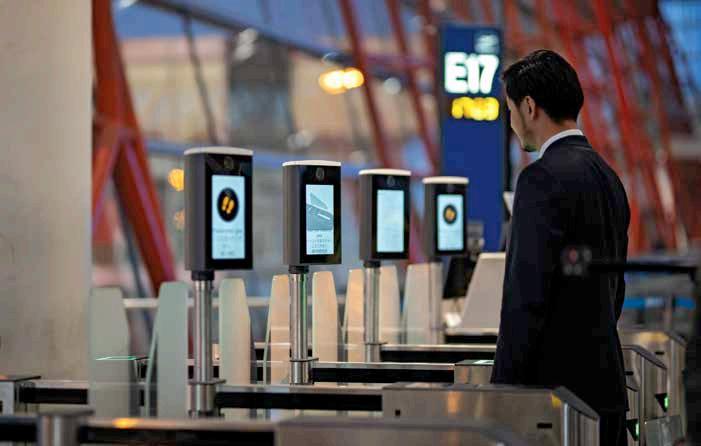
Centres for Disease Control and Prevention (CDC), the screenings are not 100 per cent effective because some travellers carrying coronavirus will be asymptomatic.
COVID-19 TESTING The International Air Transport Association (IATA) recognises that COVID-19 testing could become the new normal as global travel resumes The aviation body recently called on governments looking to introduce COVID-19 testing for travellers to deliver test results quickly and accurately.
IATA says testing must also be costeffective and not create an economic or logistical barrier to travel.
Hong Kong International was one of the first airports in the world to introduce COVID-19 testing. All inbound travellers are sent directly from the airport to an off-site testing centre at the Asia World-Expo where saliva samples are collected.
ABOVE: The SITA Smart Path biometric system BELOW: Temperature scanning at London Heathrow


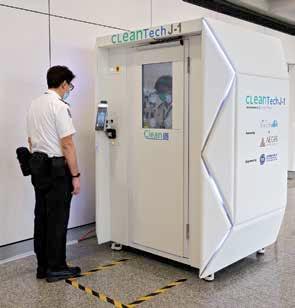
FROM TOP: Robots clean at Hong Kong International; Hong Kong is trialling a full-body disinfecting machine
The Korean government introduced “walk-through” coronavirus testing stations at Incheon International Airport in March. Travellers enter the booth, which is the size of a public phone box, where a medical staff member collects samples.
In April, Emirates became the first airline to conduct on-site rapid COVID-19 tests for passengers.
Every passenger on a flight bound to Tunisia was tested before departing Dubai International. The blood test was conducted by the Dubai Health Authority (DHA) and results were available within 10 minutes, according to the carrier.
ROBOTIC SOLUTIONS Of course, robust cleaning procedures have also become the airport norm and Hong Kong International has deployed self-driving robots to carry out these duties.
Its Intelligent Sterilisation Robots (ISR) are equipped with a UV light steriliser and an air steriliser to kill harmful bacteria. Every ISR has a head that can spin 360 degrees to spray disinfectant and a body that is lined with bulbs that emit ultra-violet lights to zap germs.
The airport is also testing a full-body disinfecting booth-style machine that could be used to sanitise passengers.
Air movement inside the booths brings any bacteria and viruses on the passenger to the surface and the antimicrobial coating on the interior kills both, according to a spokesperson from Airport Authority Hong Kong.
Singapore’s Changi Airport says it has “at least doubled” the frequency of its cleaning efforts in the four terminals and at its dedicated entertainment and retail complex, Jewel. It is now using a chemical liquid that destroys bacteria, instead of “general purpose cleaning solutions”, it stresses.











